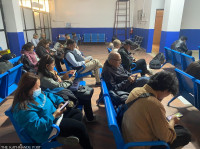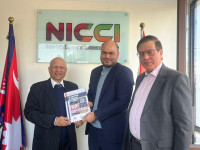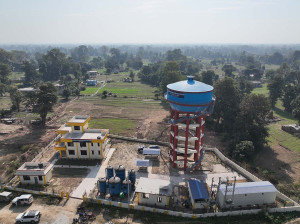Money
Fibre to the Home to reach 76 districts this fiscal year
The old copper-based landline connections will stop working in Chabahil, Gongabu and parts of Patan from September 18, Nepal Telecom said.
Krishana Prasain
Nepal Telecom aims to migrate copper-based landline connections in 76 districts to Fibre to the Home (FTTH) by the current fiscal year.
The state-owned telecoms giant rolled out FTTH technology in the country in 2015.
Upgradation to FTTH has been done in 73 districts while complete migration from copper-based landline connections to FTTH has been done in Nepalgunj, Bhairahawa, Banepa, Dhading and Kathmandu, the company said.
"It took time to upgrade the technology as we needed to coordinate with the Department of Roads and other government agencies concerned while building the network," said Shobhan Adhikari, spokesman for Nepal Telecom. The upgradation work was suspended during Covid-19.
"Nepal Telecom has been migrating its existing copper-based landline customers to FTTH without charge. New subscribers have to pay the fees," Adhikari said.
“We have been migrating copper-based landline (PSTN) to FTTH by contacting our customers wherever we have built the network. We are shutting down our copper-based landline service in areas where we have completely upgraded to FTTH,” he said.
Customers who have missed the upgrade should inform Nepal Telecom as the old technology will stop working in Chabahil, Gongabu and parts of Patan from September 18, the company said in a notice on Sunday.
The Chabahil area includes Bouddha, Baneshwor, Sinamangal, Shantinagar and other neighbourhoods.
There are different subscription packages of different prices, and customers can choose the one they want, Nepal Telecom said. The company has also launched offers and schemes on the packages.
The existing copper-based landline technology allows customers to use voice and asymmetric digital subscriber line (ADSL) broadband services.
These services are available even when there is a power cut, but FTTH does not work when there is no electricity, and customers cannot use their landline connections to make phone calls.
Frequent power outages have become a problem in recent times as the decades-old electricity infrastructure cannot handle the increased load.
Nepal Telecom said that technology needs to be upgraded with time. Customers can install uninterrupted power supply to ensure that their FTTH routers and phone lines keep working in case of a power cut.
"The copper-based telecom technology has become obsolete and the broadband speed of ADSL is slow compared to FTTH. That is why the technology has been upgraded," said Adhikari.
"Customers can obtain phone, Internet and IPTV services from a single FTTH connection, depending on the type of service they require," he said.
"When the landline connection is upgraded to FTTH, the subscriber's phone number may change by a few digits or not at all depending on the area," the company said.
“There are other technology options for migration from copper-based landline connections, but we chose FTTH as customers can obtain different services through a single cable,” said Adhikari.
According to experts, the copper wire-based technology suffers from interference from other wires. The advantage of optical fibre is that it has unlimited capacity. It also offers a higher bandwidth compared to ADSL.
Nepal Telecom has contracted Chinese companies Huawei and ZTE for upgradation from copper-based landline service to FTTH. Two separate contracts—one for the supply of equipment to upgrade the technology to FTTH, and another to build the network—were signed, the company said.
According to the management information system report of the Nepal Telecommunications Authority, Nepal Telecom had 547,737 fixed voice telephone subscribers as of mid-May this year.
Out of the 547,737 voice telephone subscribers, 430,741 were subscribers of PSTN, 56 of very small aperture satellite (VSAT) and 116,910 of wireless local loop (WLL).
Only 1.88 percent of the total population is using fixed voice telephone service as 116.02 percent of the people are using mobile service, the report shows.
Nepal Telecom accounts for 59.80 percent of voice service based on SIM subscriptions and Ncell accounts for 40.19 percent of voice service users.
Nepal Telecom has 236,390 ADSL subscribers and 1 million FTTH subscribers. The company has 5.93 million 3G users and 12.67 million 4G subscribers.
Of the total population of Nepal, 39.67 percent are fixed broadband subscribers and 94.88 are mobile broadband users.
Of the total of 27.67 million mobile broadband subscribers in the country, Nepal Telecom accounts for 67.59 percent.




 19.12°C Kathmandu
19.12°C Kathmandu













